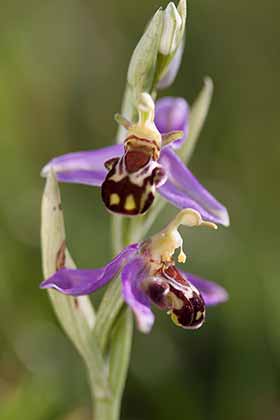Bee orchid (Ophrys apifera)
When: June - July
How many: Very scarce

The bee orchid is surely one of the wonders of nature, a plant that uses cunning, deception and subterfuge to encourage pollination.
Bee orchid flowers have cleverly evolved to resemble big, fat female bees. Male bees are attracted to visit the bee orchid by the prospect of a mating but, of course, only frustration and disappointment result. Such visits, though, serve that essential pollination purpose.
But in Britain, where the plant is towards the northern limits of its range, the bee orchid's deception is somewhat wasted as suitable pollinating insects are largely absent. Here bee orchids rely on self-pollination.
Growing to a height of 10 to 30 centimetres (4-12 inches), bee orchids are magnificent plants of striking appearance, absolutely distinctive and usually readily identified – look out for the bee orchid's velvet-like reddish-brown lower lip, patterned with greenish-yellow markings.
Bee orchids are present in the New Forest only in very small numbers - they are primarily lime-loving plants that occur only in areas of imported soil brought in, for example, during the construction of World War Two installations.
References:
Wild Orchids of Hampshire and the Isle of Wight: Martin N. Jenkinson
The Flora of Hampshire: Anne Brewis, Paul Bowman and Francis Rose
The Encyclopedia of British Wild Flowers: John Akeroyd
More links
Other related links
Search this site

Sadly, 58 animals were killed - 35 ponies, 13 cows, 8 donkeys and 2 sheep, whilst a further 32 were injured - 3 pigs, 9 donkeys, 11 cows and 9 ponies.
(Forty-three accidents occurred in daylight, 15 at twilight and 101 in the dark. Twenty-seven accidents were not reported by the driver involved).
Here's just one horrific example - Three donkeys killed in collision with van at notorious New Forest blackspot (Advertiser and Times)

